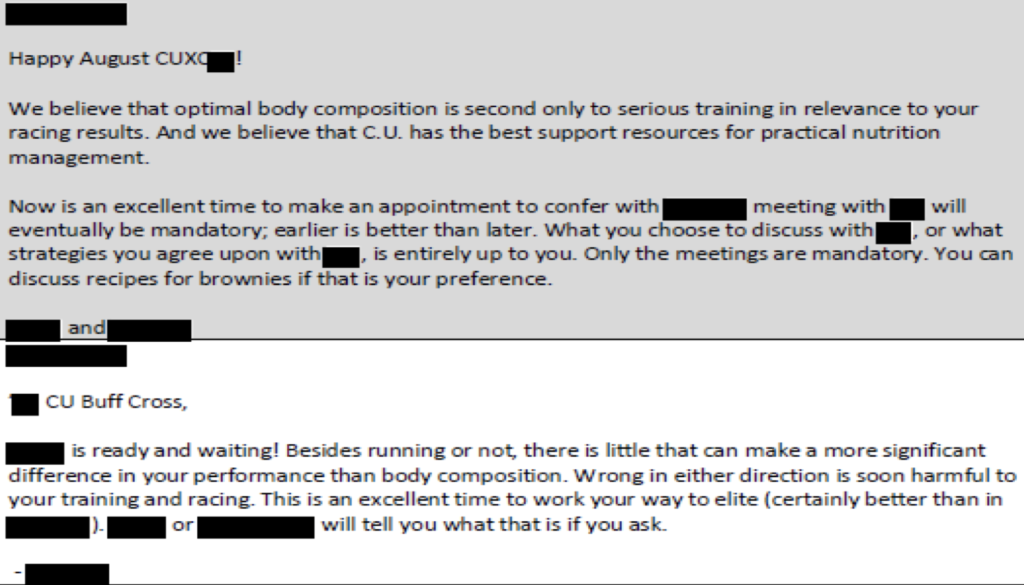
The University of Colorado released the report from the internal investigation of its cross country and track & field programs last week, and it contained some shocking details. The full 82-page report has been made public, thanks to reporting from Runner’s World’s Cindy Kuzma, and she summarized the findings here. (I recommend reading that article, along with her earlier pieces on the topic, for all the background and details.)
Among other things, investigators concluded that the “sum of seven” body composition testing performed by registered dietitian and CU’s associate athletic director for performance nutrition, Laura Anderson, supported by coaches Mark Wetmore and Heather Burroughs, negatively impacted a significant number of student-athletes. Though Wetmore, the program’s longtime head coach, said he did not receive athletes’ body composition data from Anderson, emails show that he lied about that.
Both Wetmore and Burroughs, the associate head coach, told investigators they never mandated body composition testing, but their emails and athletes’ accounts indicate otherwise. And when the testing became optional, one athlete said that Anderson told team members it was their choice whether they did the testing or not, but “not getting your body comp test done is completely asinine.”
Investigators also concluded that the cross country and track & field teams, particularly the women’s program, had an unhealthy environment. Some of the athletes who participated in the investigation used terms like cliquish, sink or swim, cutthroat, emotionally damaging, and meat grinder to describe the team culture. The report emphasized that this was not a misconduct investigation, so the investigators did not make an effort to corroborate their findings, but a lot of the witnesses had similar experiences.
Some takeaways:
- Everyone keeps their jobs. It’s concerning that investigators learned what they learned—that they have a program that is causing significant harm to some of their athletes—and nobody lost their job. CU has not done away with the body composition testing either, but athletes will need to jump through a number of hoops, outlined in this summary response, if they want to do it going forward. The summary response also indicates that CU’s athletic department implemented “specific personnel action” to the coaches and staff members involved, but the university will keep the details private.
- There was an overemphasis on body composition. It blows my mind how much emphasis Wetmore, Burroughs, and Anderson put on body composition. In a message to the team, Wetmore and Burroughs wrote, “We believe that optimal body composition is second only to serious training in relevance to your racing results.” Remember this Lauren Fleshman tweet from 2019, listing things a coach can work on with an athlete before focusing on body composition? It’s still true today, and in the college environment, I’d put a positive team culture up there as well.
In correspondence among the trio, they callously discussed team members’ bodies, making them sound like race horses or lab rats. In an email to Anderson, Wetmore wrote, “Have you calipered (Student-athlete Q) recently? (Student-athlete Q) is getting difficult and resistant, but is on a very big scholarship. I am not too worried about (Student-athlete Q’s) feelings.”
And in response to concerns about the damage the body composition testing was doing, Anderson told investigators CU Athletics does not run an eating disorder clinic; her focus was on helping student-athletes improve their athletic performance. One staff member who heard a similar comment from Anderson said they were stunned by it.
One current or former team member said that during a team meeting, Burroughs held up a sheet with everyone’s body composition numbers and compared them to a previous year’s national championship team, told them the entire women’s team was too fat, and if they wanted to win a national title, they needed to bring their body fat percentages down.
I would never argue that body composition has no bearing on performance, but when I think about ways to optimize performance, they don’t involve shaming athletes, putting pressure on athletes who already know how to put plenty on themselves, or fixating on body composition numbers. - You can take away the tools, but attitudes are slower to change. Even if CU partially removes Anderson’s ability to conduct body fat testing on athletes, that doesn’t remove the underlying belief that she, Wetmore, and Burroughs have about the importance of being lean. Coaches can still find plenty of ways to convey how important they think weight and body composition are. Four different runners reported being told they needed to lose 10 pounds. One student-athlete said that after winter break, Burroughs would often say, “Someone had too much sugar; we will need to work that off of you.”
The athlete said Wetmore often made similar comments as well, but the athletes were more likely to excuse him because he was considered “old-school” and he was from a different era of coaching. - Other athletic department staff members were concerned. At least four current or former athletic department staff members voiced their concerns about what was going on within the cross country and track & field program. One of them estimated that at least once a day, they talk with an athlete who struggles with body image as a result of their interactions with the coaches or due to the body composition testing. They also said they do not believe Wetmore understands the mental health component of being a student-athlete, and relayed a story about Wetmore joking that with all of the things student-athletes are provided, “if you are not happy here, you might as well kill yourself.” That staff member has considered quitting their job over Anderson’s use of the body composition testing, because they feel it leads to eating disorders.
- This wasn’t just “a few disgruntled, troubled people.” In an email to the team last November, Wetmore and Burroughs wrote that the program had “recently been attacked by a few disgruntled, troubled people who were unsuccessful here,” and then tried to influence the investigation by encouraging athletes to contact the administration and support Anderson.
No coach is going to get unanimously positive reviews, but it’s apparent from the report that there were many different people who could see the flaws in the program, including other staff members, and many of the complaints are very serious in nature. The student-athletes don’t come across as a bunch of people looking to complain about anything and everything, evidenced by their unanimous praise for Witness 47, former CU coach Billy Nelson. - When low body fat is what’s valued, of course men will fare better. The report found that women were more negatively affected by the body composition testing, which isn’t the least bit surprising. By nature, men, especially when they are 18 to 23 years old, are more likely to naturally have lower body fat. One male student-athlete pointed out that most of the men were told they were too lean and acknowledged that many of the women might have had a different experience. For most people, “You need to gain a little weight” is a much less stressful message to receive than, “You’re not going to have success unless you lose 10 pounds.”
- Some who have spoken out have faced a hostile environment. One recent team member said that many of their former teammates are afraid to speak out for one reason or another. And though the report didn’t include any names, I’m sure it’s not difficult for those close to the program to figure out who’s who. Seeing how Kate Intile was attacked for being the first person to come forward certainly didn’t help. (It especially infuriated me when people tried to undermine her credibility by bringing up her speed.)
And then there were the statements from alumni who support Wetmore. I am sure Wetmore has many great qualities, and I don’t doubt that many people have had positive experiences being coached by him. People are complex. But that doesn’t mean he’s not doing harm. And as Carrie Verdon told Runner’s World, “It doesn’t matter how many people had bad experiences or how many people had good experiences—if someone was told these horrible things, that is impacting their whole life, and that impacted their college career, and that is a tragedy. Even if it’s just one person, that’s enough to be like, ‘Something’s wrong, and something needs to be said about it.’”
Or, as the report concludes, “…when viewed from an individual student-athlete’s viewpoint, it is hard to see a rationale for the team environment/culture when it benefits some student-athletes but harms others.”
It’s also disappointing how few running outlets have covered the topic thus far. The longer I do this, the more I notice publications choosing to opt out of covering certain topics when they’re concerned about burning bridges. I don’t want to burn bridges with CU or its pro-Wetmore and Burroughs alums, but supporting the athletes who had the courage to speak out when they saw something that wasn’t right is more important. I don’t cover the negative aspects of the sport because I enjoy it; I cover them because I want this sport to become better for everyone. - Some athletes believed this was just the price of success. I get strong “this is just what it takes to be successful” vibes from many of the comments in the report. And I’d argue that a positive team culture, and being healthy and happy, plus calculated hard work, is going to take most people a lot farther.
A handful of athletes compared the culture on the CU cross country and track & field teams to other top NCAA programs. Witness 25 said CU was very intense but not as destructive as other distance running programs. I’m sure there are very problematic things happening in other collegiate programs, CU’s program just happens to be in the spotlight right now. But that doesn’t make what has been happening at CU okay.
According to student-athletes’ comments, it seems that Wetmore and Burroughs are relatively hands off when it comes to team culture, and some blamed the women currently on the team for the negative culture. But within a collegiate setting, setting the tone for a positive team culture is one of the most important parts of a coach’s job. Coaches can never completely control the culture, because athletes bring their own personalities to the team, but they can absolutely influence what is valued and how teammates treat one another, and help course correct if things start heading in the wrong direction.
Most of all, when I read the report, my heart breaks for anyone who felt they were the problem because they couldn’t cut it in CU’s program. It also breaks for those who bought in and may not have even realized yet the ways in which they were harmed. It can be hard to question something when it’s all you know.
A look at some of the most troubling parts of the CU cross country and track & field investigation report
Before I highlight some of the more disturbing details in the report, I will add that a lot of student-athletes had very positive things to say about CU head coach Mark Wetmore, associate head coach Heather Burroughs, and Laura Anderson, the school’s associate athletic director for performance nutrition. You can read the full report for some of those details. And in a statement to Runner’s World, Wetmore said that he vehemently denies some of the “unsubstantiated characterizations of events.”
The coaches put some concerning stuff in writing
- Most of the emails sent by Anderson, Wetmore, and Burroughs are worth reading. They start on page 31 of the report. The messages to the team in Addendums A and B, starting on page 75, are also important to read.
Select statements from student-athletes, past and present
Note that it’s often not possible to tell who is a current versus former CU student-athlete. Anyone who worked with Anderson was at the school in 2014 or later, though, because that’s the year she was hired. The witnesses’ gender was generally not included in the report, but investigators spoke with 10 current team members and 35 former team members. Of the 45 total, 28 of them were women.
- Witness 5 was diagnosed with PTSD and believes it was partially as a result of their experience in the program. They said they got the sense they thought the coaches thought mental health was a hoax.
- Witness 6 said they trusted Wetmore and Burroughs’ training advice but said they created toxic team dynamics.
- Witness 7 said she wore a sports bra and shorts at the start of her first practice and Burroughs told her she didn’t have the CU look. She also said the coaches gave those who questioned the team culture a hard time.
- Witness 8 said they didn’t want to talk about their body composition numbers because they were triggering. Anderson continued to take measurements but did not share them with Witness 8 unless they asked.
- Witness 9 praised Burroughs, but acknowledged that she can come across as “hating you” because of her level of intensity.
- Witness 10 said the coaches were focused on the “sum of seven” body composition numbers instead of other performance issues. They also said the team culture was not bad but called it “intense and unforgiving.”
- Witness 11 said Anderson told her that her sum of seven number was akin to “a regular woman on the street” and that she “had a lot of work to do.” She said Wetmore and Burroughs believed in what Anderson was doing because of the focus on science, but they were not concerned about the emotional toll the test was having. Witness 11, who experienced disordered eating, said no one would feel bad for you if you didn’t do well and called the environment cutthroat.
- Witness 14 said Anderson should not interact with college athletes because she’s “the single most harmful person” they’ve interacted with at CU. Said Anderson encouraged them to go from 112 to 102 pounds, and that Burroughs would say, “Someone had too much sugar; we will need to work that off of you.” Said Wetmore made similar comments but he was excused for being “old school.” They said they did not attend their CU graduation ceremony because they didn’t make the Pac-12 team and therefore felt they didn’t deserve to. Visiting Boulder now is triggering for them.
- Witness 15 said Anderson told her she looked like a “rec girl, like the sorority girls who do the Stairmaster during the week so they can drink all weekend long.” She said Wetmore and Burroughs’ runners are like darts. The ones that stick to the target become All-Americans and Olympians and the ones that fall to the ground become broken, both physically and emotionally. She told the investigators, “I can’t believe I made it through that (program) alive.”
- A first-year teammate told Witness 19 they hadn’t eaten carbs in three days in order to get ready to meet with Anderson. Witness 19 said Anderson would pinch and measure specific body parts and say, “This is your problem area.” They have lasting body image issues after leaving the team.
- Witness 20 said the environment is more toxic now than when they first joined the team, and they accused Wetmore and Burroughs of manipulation and emotional abuse.
- Witness 21 said Anderson told them they needed to lose four pounds from their thighs and said they “starved themselves a bit” due to the expectations around body composition. They also said that Burroughs held up a sheet with everyone’s body composition numbers, compared them to a past team, and said the entire women’s team was too fat. They said Burroughs told them to run through an injury and it took weeks to convince the coaches they were injured. Witness 21 said that there should be a book called “Running From the Buffaloes,” and said Burroughs told a teammate, “You are not the athlete that we ordered.”
- Witness 24 said they developed a severe eating disorder as a result of the body composition testing and expectations, and they continue to have related mental health issues after graduating. They said both coaches constantly gave a teammate hell about their weight and fat-shamed them. They used the words brutal, damaging, machine-like, and meat grinder to describe the team culture, and compared it to military training.
- Witness 25 described the program as intense but “not as destructive as other distance running programs.” Said the team culture was cutthroat but not toxic.
- Witness 27 says Burroughs told them they needed to lose 10 pounds, and said they got injured because they gained weight. They saw a sports psychologist to work through the trauma they experienced as a result of their interactions with Wetmore and Burroughs. They transferred to another school and had a much better experience.
- Witness 29 said their body fat and bone density numbers were low but Anderson and the medical team did not follow up, even though they were clearly in osteopenia. They realized they had disordered eating patterns for years after leaving CU and they were tired of these issues taking up so much space in their brain.
- Witness 34 said she wasn’t negatively impacted by Anderson’s testing, but she understands how it could have been harmful for others. After a poor race, she says Wetmore and Burroughs told her to go see Anderson because she looked like she had gained weight. But she said she had a positive experience on the team and would encourage others to run for CU.
- Witness 35 said the team environment is harsh and, “It’s a business, you’re a number, and your value is related to the points you score.” They said runners were leaving CU depressed and with other mental health challenges. They talked to a CU runner from the 2000s who said they still have an eating disorder from training with Wetmore and Burroughs. Witness 35 said any performance advantages are not worth impacting people’s lives in this way.
- Witness 36 said that when the body composition tests became optional, Anderson told the team, “You can come and see me and we can talk about brownie recipes instead, but not getting your body comp test done is completely asinine!” They said Burroughs told them they weren’t as good as they were in high school because they weigh more now. They developed an eating disorder while at CU, and Anderson ignored their request not to do the testing. They said Burroughs told them to run through stress reactions in both tibias and that she encouraged athletes not to get an MRI because then there’s a record of their injury and the athletic trainers would keep them from training. They continue to have mental health struggles as a result of their time in the program and called the culture “toxic” and “fucked.”
- Witness 37 said they told the coaches they needed blood work because of their iron issues, and Burroughs told them there was nothing wrong, they were slow because they had gained too much weight. They report that Burroughs said they needed to lose at least 10 pounds if they wanted to race that year. They said nearly every year, at the start of the cross country season, Wetmore or Burroughs pulled them aside and said they “clearly hadn’t been running that summer because it was no secret they had gained a little weight.” They said they had roommates who had eating disorders and instead of encouraging them to get healthy, the coaches encouraged them to run more or keep losing weight.
- Witness 39 said they hoped the coaches would be fired. They think the program has ruined careers and lives. They said they would forgo the rest of their eligibility rather than continuing to run for Wetmore and Burroughs. They said there was a “sink or swim” mentality within the program and if you are sinking, the coaches do nothing to help you up.
- Witness 40 said the program is toxic and cliquey.
- Witness 55 said that after a DEXA scan, they were told they needed to lose 10 pounds, and a senior talked to the team about running faster due to losing weight over the course of their CU career. Witness 55 developed an eating disorder and saw the same happen to both their male and female teammates. Because of the pressure, they tried to go off their anxiety medication to lose weight, and they have difficulty returning to Boulder now because of the memories it brings back. They said a teammate struggled with depression and suicidality and Burroughs told them to “go jump off a cliff already.”
- Witness 58 said Wetmore would talk about team members’ weights and use skinfold calipers in front of the whole team. Witness 58 says they remember a teammate fasting because Wetmore told them they were fat. They had poor mental health because of the CU running program and eventually transferred.
- Witness 60 said the distance environment was very toxic.
- Witness 61 was at a track meet and was extremely cold. She said Wetmore asked her why she was cold and said, “We do not have you skinny enough to be cold.” She read the Runner’s World article in November 2022 and thought, “Oh my God, this is still going on.”
- Witness 63 appreciates everything Wetmore did for them, but said that how he handled body composition was dangerous and inappropriate. They said that after the women’s team didn’t perform well at nationals, Wetmore told the team they would have to have their body fat measured in the Bod Pod weekly. They say the women were told they should have 9–12% body fat for optimal performance.
Select statements from athletic department staff members, past and present
- Witness 3 said they weren’t surprised that so many cross country athletes struggle with their mental health after leaving the CU program, and that the sum of seven body composition testing is detrimental to athletes.
- Witness 49 said the medical literature does not support Anderson’s conclusions about leanness correlating with performance. They said student-athletes have come to them and their colleagues with concerns about things Wetmore and Burroughs have said to them that would be considered fat-shaming. They indicated that the cross country and track teams make up 25% of the Psychological Health & Performance (PHP) caseload, leading the way for CU teams. And they said they were not surprised that former CU runners continued to struggle with their mental health long after they left CU.
- Witness 50 said that the emphasis on leanness in athletes directly impacts their bone density during critical years. They performed a study and found that, on average, the CU athletes were not building bone density during those years. They said the medical staff has indicated that they feel strongly that the sum of seven body composition testing should not be used on CU athletes. They said the smaller is faster mindset is dangerous and the university they previously worked at had a healthier culture.
- Witness 52 said that Anderson overestimated her abilities and positioned herself as a medical doctor of sorts. Witness 52 recommended that Anderson and the coaches stop doing body composition testing on certain athletes, especially those with eating disorders, but Anderson ignored that advice. Witness 52 said Anderson has openly said, “We are not an eating disorder treatment center,” which stunned them. Witness 52 has considered quitting their job over the use of the body composition testing because they feel it creates eating disorders. They estimated they talk with an athlete who struggles with body perception issues caused either by the coaches’ interactions or body comp testing at least once a day. After a mental health crisis, they attended a meeting where Wetmore joked that with all the things they provide student-athletes, “If you are not happy here, you might as well kill yourself.” Witness 52 said Wetmore doesn’t understand the mental health component of being a student-athlete.





